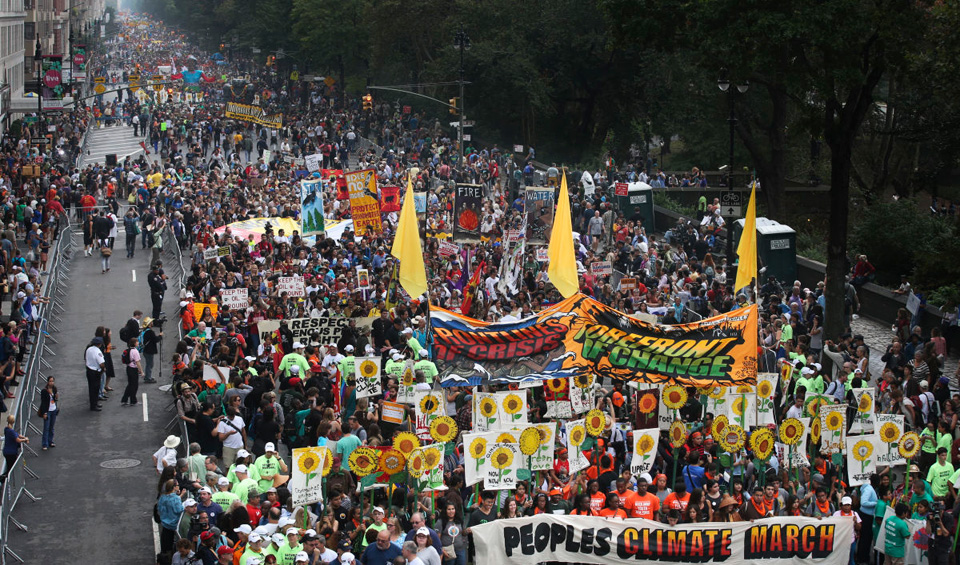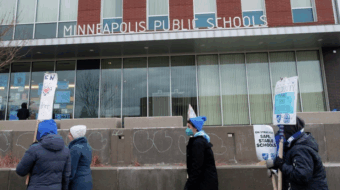
Oakland, Calif. – Election night November 6 at approximately three hours past midnight the unexpected news that Donald Trump had secured the presidency left me dumb struck. Numb from head to toe.
Humanity and the planet had just crossed the point of no return. The death knell had just struck…or so it felt. Come to find out I was not alone in feeling that sense of gloom and doom.
Trump’s actions on climate change ever since that fateful moment have confirmed our worst fears. So, I’ve asked myself the inevitable: Can humanity survive Trump’s scorched-earth climate policies? What are Americans and the world community of nations doing about it? And what can we do together to up the ante?
Any fruitful strategy will require the most massive concerted participation of the American people.
New data released by the Yale Program on Climate Communication gives the most detailed view yet of public opinion on global warming, the NY Times reported March 21.
Nationally, about seven in 10 Americans favor regulating carbon pollution from coal-fired power plants. And 75 percent support regulating CO2 as a pollutant more generally.
In every congressional district, a majority of adults favor limiting carbon dioxide emissions from existing coal-fired power plants.
However, a cautionary note: The study found that while Americans overwhelmingly believe global warming is happening and that carbon emissions need to be scaled back, fewer are sure that the changes will harm them personally.
When faced with imminent threat, we humans are likely to react quickly. But, against slow moving and somewhat abstract threats, we tend not to be highly motivated to act even if the challenges are ultimately dire.
For example: The effects of climate change, including sunny-day flooding, are being felt across Florida. But the state shows a distinct north-south split in the level of concern over global warming, and it is not a simple Democrat-versus-Republican distinction, said state representative Kristin D. Jacobs, a Democrat. Four southeast Florida counties — Miami-Dade, Broward, and Monroe and Palm Beach — stand out because of their concerted effort to work on climate issues together and to discuss it in nonpartisan terms.
Clearly, Trump’s plan to destroy the Environmental Protection Agency (EPA) and overturn former President Barack Obama initiatives aimed to reduce greenhouse gas emissions goes against the sentiments of the overwhelming majority of the American people.
But, wait! Even though a whooping majority of Americans favor regulating CO2 gas emissions, how can we expect them to embrace renewable energy? Isn’t renewable energy a job killer, as Trump and Republicans argue?
Not so, says Sierra Club Executive Director Michael Brune. According to new Sierra Club analysis of Department of Energy jobs’ data, nationally clean energy jobs outnumber fossil fuel jobs by more than 2.5 to 1.
When it comes to coal and gas – two sectors President Donald Trump has promised to bolster – clean energy jobs outnumber jobs dealing with those two fossil fuels by 5 to 1.
“Right now, clean energy jobs already overwhelm dirty fuels in nearly every state across America, and that growth is only going to continue as clean energy keeps getting more affordable and accessible by the day,” the Sierra Club’s Brune said in a statement. “These facts make it clear that Donald Trump is attacking clean energy jobs purely in order to boost the profits of fossil fuel billionaires.”
Just nine have more clean than dirty fuel jobs
Out of all 50 states, just nine have more jobs in fossil fuels than in clean energy. Some of the largest discrepancies between clean energy jobs and fossil fuel jobs were in states like Florida, Michigan, Wisconsin, Pennsylvania, and Indiana, where jobs in renewable energy “vastly exceeded jobs in the fossil fuel industry,” according to the Sierra Club’s analysis. Many of these places also happen to be states that helped Trump win the presidential election in November.
And 25 U.S. cities have committed to transitioning to renewable energy, with a handful of those pledges coming after the November presidential election.
Even among Trump supporters, policies to incentivize the growth of clean energy are overwhelmingly popular — 75 percent of Trump voters think that the federal government should take steps to accelerate the development and use of clean energy in the United States. Only 58 percent of Trump supporters want to see more emphasis on natural gas, and just 38 percent want more emphasis on coal.
Undoubtedly these two studies shine rays of hope in what at first seemed a gloomy post-election scenario.
The gloom and doom felt by many in the election’s aftermath quickly began to dissipate with the Women’s March. This was the biggest out-pouring of peopleprotesting ever in our nation’s history. The resistance unfolding ever since continues to be the most diverse in terms of demographics, social composition and fronts of struggle I’ve (and many others have said) ever witnessed.
Also huge was the March for Science last Saturday and expected-to-be huge is the People’s Climate marches (PCM) this weekend.
Multiracial, multiethnic, multi-gender, multigenerational, multidenominational, immigrants, disabled, and other especially oppressed peoples have been in the ranks of all the demonstrations.
As with other recent mass actions, the demonstrations this Saturday, April 29, are a venue for recognizing and making the environmental connections with the most varied coalition of social issues and movements coming under the Trump/Republican chopping block. The Blue-Green Alliance (the coalition of labor unions and environmental groups), Native American tribes from North Dakota and beyond, Black Lives Matter and civil rights organizations, civil liberties groups, the Immigrant rights movement, Planned Parenthood and the main women’s organizations, are but a few of the progressive social movements represented.
In addition, there is a groundswell of public officials and governments at the local, state and provincial, regional and transnational levels.
People are engaging in non-violent street heat, use of the courts, and engaging in legislative and electoral action all leading up to the coming 2018 elections.
California is taking a leading role. California’s seven GOP congressional targets represent nearly a third of the 24 seats Democrats need to flip in 2018 to take control of the nation’s House of Representatives. Nationwide, the Democratic Congressional Campaign Committee has identified 59 Republican-held districts they believe can be flipped.
At a town hall meeting recently Organizing for Action and Indivisible, together with California Democratic Rep. Barbara Lee, laid out a plan for mobilizing a small army of volunteers to help out in these seven congressional districts now held by Republicans. Similar initiatives are being organized in other parts of the state. These volunteers from districts led by Democrats will be joining with newly energized local constituents in the targeted Republican-controlled districts, many of whom participated in the protests at town hall meetings sponsored by Republican representatives during the congressional recess.
The goal is to conduct door to door organizing, educational and action-oriented drives on the pressing issues of the day throughout the year that would flow right into election periods with voter registration, education, canvassing, phone banking and get-out-the-vote drives. The idea is to help constituents in Republican districts come to recognize what’s in their best interests and to win them over to a pro-people agenda. They are, after all, the key to electoral victories.
The most pressing challenge is to engage in action to defend what we’ve won so far at the federal level, make inroads in states and cities in favor of renewable energy and other environmentally sound measures, and generate electoral gains at the federal, state and local levels in order to begin tilting the overall balance of forces in the people’s favor. At the same time, the plan is to advocate for more advanced demands such as the creation of a federal superfund for workers being displaced from fossil fuel industries, as in mining, to transition to green jobs, a guaranteed income and training/education for new jobs for the duration of unemployment, and rebuilding of affected communities.
A green economy and jobs is in renewable energy but it also includes more energy efficient buildings, homes, means of public transportation and personal vehicles (hybrids and electrical), conservation, reforestation, and more. The potential for job creation is huge.
The dominant sections of capital associated with the far right feel that, with their man in the White House and their Republican toads in Congress, they can put the peddle to the metal with fossil fuel, increasing and consolidating their sphere of influence worldwide.
But, at the same time, we have a burgeoning renewable energy section of capital. We may not see eye to eye on unionization, public control (much less when combined with public ownership) of the energy sector, and other questions. But, we do agree on moving rapidly and massively on renewable energy and other sustainable initiatives.
Indispensable at this time
At this stage in the struggle to substantially reduce greenhouse gas emissions and defeat the rightwing politically, they are an indispensable ally.
This in no way means abandoning the primacy of the labor-progressive social movements rooted in the progressive people’s majority.
This does not mean putting on hold fighting for strengthening the public sector where possible, unionization, and advancing other fronts favoring working people as well as advocating for more advanced solutions, including arguing for a fundamental socialist alternative based on our nation’s democratic traditions and in keeping with the interests of the people.
The case of the fox guarding the chicken coop
The Trump administration’s proposes to cut the budget of the Environmental Protection Agency (EPA) by 31 percent, by far the largest cut of any federal agency. Recently leaked EPA documents outline plans to cut the agency’s workforce by 25 percent, while eliminating some 56 programs including programs aimed at monitoring and protecting public health and the environment.
Trump’s appointed EPA Administrator Scott Pruitt sued the agency more than a dozen times as Oklahoma’s attorney general. Pruitt has deep ties to the fossil fuel industry. He also does not accept the scientific consensus on climate change, refuting that carbon dioxide emissions are the primary cause of global warming.
The move by Trump to overturn former President Barack Obama’s considerable environmental initiatives comes at a dangerous time. The NASA and the National Oceanic and Atmospheric Administration warn 2016 was the hottest year on record globally, in the third straight year of record-breaking temperatures. For people across the global south, climate change is already sowing disaster. Worsening droughts have jeopardized the food supply of 36 million people in southern and Eastern Africa alone.
It does not bode well for nations across the globe that the Trump administration’s Secretary of State is former Exxon Mobil oil tycoon Rex Tillerson, given that oil, other fossil fuels and extractive commodities continue to play dominant roles in the imperial quest for economic, political and military spheres of influence.
Legal challenges in the making
Legal experts say it could take years for the E.P.A. administrator to carry out the process of withdrawing and revising the climate change regulations, and the process will be hit by legal challenges at every turn. A coalition of states, including New York and California, has already vowed to fight Mr. Trump.
Curiously enough, the first reported legal challenge comes in a hybrid form, adding one more obstacle to Trump’s much heralded wall along the border with Mexico. Last week, the Center for Biological Diversity announced it had filed a lawsuit against the Trump administration charging the government failed to complete an environmental analysis of the southern border — violating the National Environmental Policy Act — before moving forward with plans to build a wall along the United States-Mexico border.
Role of cities, states and other nations
In November of last year, Jeff Bridges writing for the New YorkTimes, reported that worldwide cities produce as much as 70 percent of greenhouse gas emissions. Seventy percent of those cities are already dealing with extreme weather like drought and flooding.
It’s no wonder that the concept of “regenerative” cities won broad support at a recent gathering of city leaders from around the world in Quito, Ecuador, hosted by the United Nations. The Habitat III conference approved a “new urban agenda” that urges cities to adapt to climate change but minimize their harm to the environment and move to sustainable economies.
Over 10,000 climate initiatives are underway in cities worldwide, according to the C40 Cities Climate Leadership Group, which represents 80 major cities.
For all of Trumps vitriol about the Chinese inventing the climate change “hoax” in order to hoodwink our country into abandoning fossil fuel thus stripping us of our superior economy, China has emerged as a renewable energy super-power.
Writing in the NY Times Keith Brasher wrote earlier this month that Chinese companies now control almost ½ of the $45 billion global market for wind turbines.
China is now home to two-thirds of the world’s solar-production capacity. Because China also buys half of the world’s new solar panels, it now effectively controls the market.
Solar-panel prices have fallen close to 90 percent over the past decade.
At the same time, while coal still remains the main source of energy in China, its use has leveled off and in time is expected to be replaced by solar, wind, hydroelectric and nuclear power.
With generous government assistance, growing technical sophistication and a comprehensive plan to free itself from dependence on foreign companies, China aims to become dominant in industries of the future like renewable energy, big data and self-driving cars.
Nirmala Sitharaman, the Indian minister of state for commerce and industry, said the country was ready for a bigger global role in mitigating climate change. She pointed to the International Solar Alliance, a coalition of more than 120 countries that seeks $1 trillion in investments to ramp up solar energy generation. The alliance was first proposed by the Indian prime minister, Narendra Modi.
The lure of a potentially huge market for clean energy and other technologies that would help mitigate climate change was a driving force, analysts said. They are also motivated by the risks posed by rising seas, extreme weather and other consequences of unmitigated climate change.
The International Energy Agency estimates that renewables will remain the fastest-growing source of electricity into 2021, reaching nearly 30 percent of all power generation by then.
Among states, California and New York leading on the home front
In the U.S. California’s recent move to reduce its carbon emissions by 40 percent below 1990 levels by 2030 is a hopeful sign for other cities and states to follow.
A dozen states are emulating California’s rules on tailpipe emissions, and even more are setting benchmarks for increasing renewable energy. But persuading them to adopt other, more ambitious policies, such as requiring polluters to pay fees through a cap-and-trade system.
“We’re not close,” said Kate Larsen, an Oakland-based director at the Rhodium Group, which tracks climate policies. “There still needs to be a lot more from many other states to hold off the damage from the Trump administration.”
Meeting the Paris target was always going to be difficult — all of former President Obama’s policies combined would not have been enough to sufficiently slash emissions by the deadline, according to research from the Lawrence Berkeley National Laboratory.
The United States must slash emissions by at least 26% below 2005 levels by 2025 to hit its target in the Paris agreement.
But, EPA administrator Pruitt recently called for an “exit” to the historic 2015 international climate agreement.
Environmental advocates say changing the landscape will mean increasing their pressure in statehouses, which are mostly controlled by Republicans.
“The same political forces and money that are behind the retreat away from climate action in Washington are also present in states around the nation,” said Jeremy Symons, associate vice president for climate political affairs at the Environmental Defense Fund. “It’s going to take the inevitable public backlash that we expect, and are already starting to see, to turn things around.”
He did point to progress in some states led by Republicans, who see potential for new jobs and lower prices in renewable energy. Since Trump won election, Illinois Gov. Bruce Rauner and Michigan Gov. Rick Snyder signed legislation boosting solar and wind power in their states.
There are other areas where California is prepared to anchor the battle against climate change. It’s the only state in the country allowed to set tougher rules on tailpipe pollution than federal standards, and regulators here are pushing forward cutting emissions despite potential opposition from Trump.
The decision could affect nearly half of the country’s vehicle market because a dozen states have adopted California’s policies as their own.
Brown has also emphasized his partnership with New York Gov. Andrew Cuomo. Combined, their two states represent one-fifth of the country’s economy, and they’ve set similar targets for reducing emissions.
When Trump announced his decision to roll back Obama’s Clean Power Plan last month, Brown and Cuomo pledged to keep fighting climate change “with or without Washington.”
With states like California and New York showing the world that we’re pushing forward, it will send a huge signal to the international community.
“I do believe that science and peer-reviewed research — and essentially the truth about the world — will ultimately prevail,” Brown said. “The only question is if it will be too late.”










